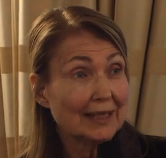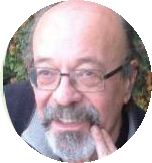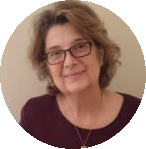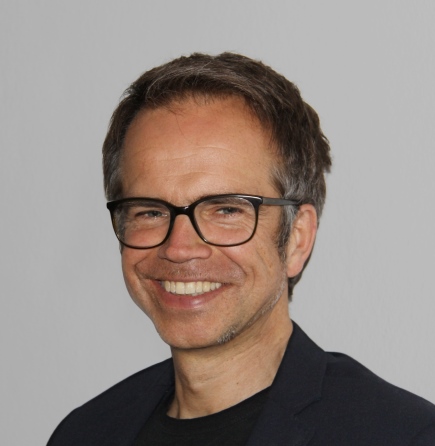
The 2017 seminars in London, Geneva and New York explored the theme: From the Unreal to the Real. The meetings contained some deep reflections on the nature and importance of truth, in four main areas: journalism/media; education; science; and art. Because of the wealth of material, and the interesting connections between the speakers’ thoughts, the seminar report will be spread over two issues of the Newsletter. There is a summary of ideas addressed by each speaker and some key quotations have been highlighted. The full content of speakers’ presentations is available on video at worldgoodwill.org/video. In this issue truth is considered in the fields of journalism/media and education. The next issue will do the same for science and art. We hope that this approach will prove illuminating – please let us know.
Before considering the thoughts of the presenters, here are some initial ideas to help orient our inquiry. Like a multi-faceted gem, truth can be approached from many angles. One natural place to begin is to consider language as one of the major ways in which we seek to convey the truth. After all, what could be clearer than words? Yet as soon as we turn to the dictionaries of the world, we realise the quandary – for words themselves are limited in how much they can tell about an event. Every definition is already a ‘moveable feast’, with the meanings of many words shifting over the centuries. And different languages divide up the world differently. So in an important sense, words only point the way towards the truth. Nevertheless, words are the main tools with which we seek to capture the truth, (although images are fast becoming another important avenue) so we must pay careful attention to who is using them and for what reason.
An important consequence of the way in which the meanings of words naturally evolve over time is that we should always be wary when an individual or group insists that there is only one ‘true’ meaning for a word or idea. In that direction lies the peril of dogmatic thinking which has bedevilled institutions of all kinds, not just religion, since the beginning of time. Claiming to know the one true meaning immediately closes the door to civilised debate and friendly disagreement, narrowing the possible futures we may hope to inhabit. From the angle of esotericism, our whole universe is a continually evolving field of life, consciousness and form, so it would be very strange if an idea, embodied in a word or series of words, were to suddenly reach its final form while everything else continued to change. It is instead almost an axiom of the esoteric perspective that the deep, spiritual truths which underlie our everyday lives are progressively revealed in richer contexts and finer nuances as our ability to register the subtler levels of existence increase. Perhaps it is an understandable mistake, to confuse the timeless Ideals of the Good, the True, and the Beautiful with the particular definitions that they have received over time. But that mistake is magnified if individuals or groups then believe they have the right, or even the duty, to impose those definitions on others. The remedy to this divisive approach is through the loving wisdom of the soul, which is always inclusive.
Apart from the rigidity of dogma, there is also the danger of the unscrupulous use of language, with the intention to manipulate or even deceive others for selfish gain. This most often appears in the fields of politics and commerce. Glamour is one word for this phenomenon – and while the ordinary definition of this term suggests frivolity and decadence, the more esoteric understanding sees it as the attempt to veil the real and the true, on physical, emotional and mental levels. Indeed, the deliberate effort to see ‘through’ glamour by the light of the soul and the intuition, is a major challenge for all who seek to follow the spiritual path.
Turning from language itself to those in the media who are entrusted with its use, another dimension of the struggle to move from the unreal to the real emerges – truthfulness. We trust journalists to act as the witnesses to nearly all of the major events which shape our daily lives. Yet we recognise within ourselves the possibilities of error and distortion in our perception of all but the simplest of physical events. So we must likewise reckon with the fallibility of journalists in their efforts to convey to the public what actually happened. And journalists must often rely not only on their own perceptions, but also on the perceptions and words of their sources, who will have their own fallibilities, and conscious or subconscious agendas. All of these factors may affect what journalists will emphasise in their reports, the way they present their observations, and what they choose to omit. There is one final link in the chain between an event and its understanding, which is the conscious or subconscious agenda in the mind of the audience. If an agenda is deeply rooted enough, some audiences will only hear what they want to hear, no matter how skilfully or convincingly a contradictory argument or facts are presented. The linguist and social critic Noam Chomsky has further identified five filters present in the media, which he sees as helping to promote a climate of fear and entrenched inequality: the excessive concentration of media ownership in the hands of a few powerful figures; the funding of media by commercial advertising; an over-confidence in the truthfulness of official sources; politicians criticising the media in order to keep it in line; and finally, the tendency of mainstream media to stick only to mainstream beliefs and opinions, the ‘status quo’.
One more obscuring veil has very recently emerged – the atomising influence of social media on news consumption. In contrast with the traditional ‘stance’ of a newspaper, which can be compared with one’s own perspective, social media unmoors stories from any recognisable editorial stance, with little or no emphasis on the reliability of either the information or the sources. Serious global issues are strewn randomly throughout the same feed as cat pictures and celebrity antics. Thus, everything is accorded equal ‘importance’ and truth is in danger of becoming merely what makes you feel good.
Finally, the question of truth connects fundamentally with the question of freedom. As noted earlier, certain media practices can create a climate of fear and uncertainty. But we are only truly free when we are free from fear, no matter how democratic our societies appear to be. Fear can stifle the expression of love. Thus we are all responsible for observing our society lucidly, and part of this involves cleansing our own perceptions. The need is therefore to return to the true self through meditation, leading to the ability to discriminate between truth and falsehood. Discrimination is only possible when the mind is aligned with the soul and submits itself to the light of the intuition through a humble heart and simplicity of mind. This enables us to recognise that our picture of truth is always limited, that the landscape of truth is in fact infinite. Meditation allows us to move from the truth contained in words, to those veiled by symbols, to that highest spiritual truth that can only be experienced in silence.
There are a number of ways in which the ideas of our presenters could have been organised – each one would probably shine a different light on our theme. Here are some suggestions for connections amongst them.
Christopher Schwartz focuses in on the responsibilities of the individual journalist to reporting the truth, on how different kinds of journalist might interpret that task, and on the philosophical and spiritual dimensions of seeking to be an ‘impartial spectator’. Judy Rodgers takes up a related theme: empowering journalists and other media makers to present a positive way of framing difficult narratives. The organisation Judy founded, Images and Voices of Hope involves hundreds of media professionals in efforts to uncover a deeper layer of truth through a more spiritual approach to outer events, and this echoes Christopher’s final thoughts on how responsible journalism has much in common with the spiritual efforts of Sufi and Tibetan Buddhist meditators.
Gabriel Jaraba reflects on the need for a deepened media literacy in our technological age when the collective mind of humanity has been given physical form through the Internet. Media literacy is a means of defending democratic freedoms, and ultimately of realising a planetary society based upon goodwill and right sharing. Alexandra Ratcliffe gives a brief overview of the history of information sharing, noting the fairly recent emergence of organised propaganda techniques, and the essential importance of education for media literacy to counteract this tendency, in order to defend freedom of thought. Like Gabriel, Alexandra focuses on the protection of democracy. She also highlights the importance of teaching meditation, to give people a way of attuning to media where the good, the true and the beautiful are on display. This connects with both Judy and Christopher, and provides a link to the final piece by Andreas de Bruin, who shares his positive experiences introducing a variety of meditation techniques to university students, and his latest project, which concerns the use of meditation to unveil the deeper meaning of the art of the Old Masters. Both projects have the broader aim in view of allowing the meditator to become of service to the wider whole.
Modern Journalism Reflects a Shift in Consciousness
 Christopher Schwartz is an American researcher and journalist. He is currently conducting doctoral research at KU Leuven’s Institute of Philosophy in Belgium, while instructing at the American University of Central Asia in Kyrgyzstan, where he also works as a journalist. He is a member of the Bahá’í faith. He quoted the founder of the Bahá’í faith, Bahá’u’lláh, who in the late 19th century wrote that journalism is one of the distinctive features of the modern age: “The pages of swiftly-appearing newspapers are indeed the mirror of the world. They reflect the deeds and the pursuits of divers people and kindreds...[journalists should be] attired with the raiment of justice and equity. They should inquire into situations as much as possible and ascertain the facts, then set them down in writing.” (emph. added). Journalism, Christopher proposed, represents “a new human capacity that has been unlocked and is used by human beings. It’s the underlying shift in consciousness that is the real story.”
Christopher Schwartz is an American researcher and journalist. He is currently conducting doctoral research at KU Leuven’s Institute of Philosophy in Belgium, while instructing at the American University of Central Asia in Kyrgyzstan, where he also works as a journalist. He is a member of the Bahá’í faith. He quoted the founder of the Bahá’í faith, Bahá’u’lláh, who in the late 19th century wrote that journalism is one of the distinctive features of the modern age: “The pages of swiftly-appearing newspapers are indeed the mirror of the world. They reflect the deeds and the pursuits of divers people and kindreds...[journalists should be] attired with the raiment of justice and equity. They should inquire into situations as much as possible and ascertain the facts, then set them down in writing.” (emph. added). Journalism, Christopher proposed, represents “a new human capacity that has been unlocked and is used by human beings. It’s the underlying shift in consciousness that is the real story.”
Christopher then explored the etymology of ‘journalism’, indicating that it comes ultimately from the verb ‘to shine’. Thus “the true task of a journalist is to illuminate – illuminate in both an intellectual cognitive sense and in a spiritual sense, a moral sense.” Another theme which he wanted to address is the difference between a subjective and an objective perspective, which he suggested are not opposites, as they are often portrayed. Rather, objectivity is concerned with being the focus or subject of another’s attention, and is connected with the journalistic ideal of the ‘impartial spectator’.
Finding a way to be impartial and report the whole truth is a difficult challenge for journalists, as the well-known parable of the blind men and the elephant shows. To illustrate this point, Christopher shared the results of an extensive survey of journalistic attitudes which identified four major ways in which journalists see themselves. The first is as a ‘Populist Disseminator’. This implies a very close identification with the journalist’s intended audience. The idea is to serve ‘the people’, and a journalist of this kind is mainly neutral towards the establishment, except where its  interests or actions conflict with those of ‘the people’. A ‘Populist Disseminator’ believes that it is not their primary task to persuade an audience of the truth, but to edify them. The second kind of journalist is an ‘Opportunist Facilitator’, who is closely identified with the establishment. Like the ‘Populist Disseminator’, they are less focused on discovering the truth: instead, they wish to support the establishment agenda. So they are not necessarily interested in persuading their audience of something unless they believe the establishment wishes it. This kind of journalist may find themselves in a dilemma on how to act when there is a major change in the establishment, as the result of elections or revolution. The third kind of journalist is the ‘Critical Change Agent’, who actively desires to affect the socio-political agenda, and to inspire their audience to act for change. The ‘Critical Change Agent’ is usually critical of the establishment, so if their work is successful and their recommendations for change are adopted, they find themselves in the opposite dilemma from that of the ‘Opportunist Facilitator’ – how to avoid being incorporated into the establishment. The fourth kind of journalist is the ‘Detached Watchdog’, who values ‘impartiality’ and ‘objectivity’ above all. Such journalists believe that hard truths may be necessary for social progress, and while they are typically hostile towards the establishment, since the establishment does not usually give the populace full information, they may also question whether social activists are going too far, or are pursuing a covert agenda. As a result, they may often find themselves to be in conflict with their society, and may think of themselves in terms of a ‘loyal opposition’.
interests or actions conflict with those of ‘the people’. A ‘Populist Disseminator’ believes that it is not their primary task to persuade an audience of the truth, but to edify them. The second kind of journalist is an ‘Opportunist Facilitator’, who is closely identified with the establishment. Like the ‘Populist Disseminator’, they are less focused on discovering the truth: instead, they wish to support the establishment agenda. So they are not necessarily interested in persuading their audience of something unless they believe the establishment wishes it. This kind of journalist may find themselves in a dilemma on how to act when there is a major change in the establishment, as the result of elections or revolution. The third kind of journalist is the ‘Critical Change Agent’, who actively desires to affect the socio-political agenda, and to inspire their audience to act for change. The ‘Critical Change Agent’ is usually critical of the establishment, so if their work is successful and their recommendations for change are adopted, they find themselves in the opposite dilemma from that of the ‘Opportunist Facilitator’ – how to avoid being incorporated into the establishment. The fourth kind of journalist is the ‘Detached Watchdog’, who values ‘impartiality’ and ‘objectivity’ above all. Such journalists believe that hard truths may be necessary for social progress, and while they are typically hostile towards the establishment, since the establishment does not usually give the populace full information, they may also question whether social activists are going too far, or are pursuing a covert agenda. As a result, they may often find themselves to be in conflict with their society, and may think of themselves in terms of a ‘loyal opposition’.
Christopher invited the audience to give their opinion on which kind of journalist they felt was best. The result was largely in favour of the ‘Detached Watchdog’. He noted that he himself largely identified with this type, with the emphasis on ‘Detached’, partly because as a Bahá’í he did not believe in adversarial relations, and also because he has seen at first hand examples of how colleagues who identify with this position can become very negative and pessimistic. However, he also believes that every journalist has traces of all four types present within them – for example, his inner ‘Populist Disseminator’ would define ‘the people’ as the whole human race – and each type is dedicated to some version of truth. And of course, every type can stray from that dedication, because of intimidation or corruption.
 Christopher returned to the question of what ‘objectivity’ really means. He suggested that it implies a stepping outside of your personal frame of reference, to reach a perspective that is outside perspectives, a ‘view from nowhere’. One way to understand this is to consider different levels of truth. In the everyday physical realm, we have the truth of empirical facts; whereas in the timeless realm of morality and spirituality, we have perennial truths, deep intimations of what is right or wrong, true or false. Objectivity is connected with this latter realm of truth – according to Christopher, “objectivity ultimately, it is this highest level of potential truth... being in a stance of pure and utter compassion.”
Christopher returned to the question of what ‘objectivity’ really means. He suggested that it implies a stepping outside of your personal frame of reference, to reach a perspective that is outside perspectives, a ‘view from nowhere’. One way to understand this is to consider different levels of truth. In the everyday physical realm, we have the truth of empirical facts; whereas in the timeless realm of morality and spirituality, we have perennial truths, deep intimations of what is right or wrong, true or false. Objectivity is connected with this latter realm of truth – according to Christopher, “objectivity ultimately, it is this highest level of potential truth... being in a stance of pure and utter compassion.”
To give an example of this type of consciousness, he invited the audience to think about a moment of serious disagreement or conflict where eventually a point of consensus was reached. He asked them to think not about the specifics of the disagreement, but about the process of synchronizing viewpoints, the ‘Ah-ha’ moment where sympathy for and understanding of the other perspective appeared, and then the desire to reconcile – even if the conclusion was that you would ‘agree to disagree’. He asked the audience to “remember instead the process of negotiating and synchronizing your viewpoints”. That process is the experience of objectivity, the ‘view from nowhere’, where two people move from their subjective ‘someone-ness’ and together both became ‘no-one’, a third point in the triangle between them. This viewpoint can be identified with the ‘impartial spectator’, which historically is a concept that journalists introduced, beginning with newspapers. This notion of becoming an ‘impartial spectator’ is one that can also be found in Sufi Mysticism and Tibetan Buddhist writings. As Christopher asked, “what does it mean to become nobody, to become the Impartial Spectator? It is to become a mirror.” This echoes the thought from Bahá’u’lláh concerning newspapers becoming a mirror of the world. However, 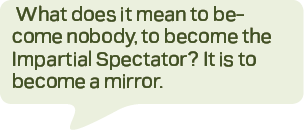 we should remember that even a mirror is subject to imperfections. Indeed, Bahá’u’lláh was sceptical of the claims of some Sufi mystics to become completely united with God and thus completely impartial in their viewpoint. The point is that, not just as journalists – although this is a specific part of their vocation – but simply as humans, we must strive to do this. At the same time, we should recognise the subtle pitfall of pride that comes with this mystical endeavour, to believe we have fully succeeded, and that we know what objectivity and THE truth are. worldgoodwill.org/video#cs
we should remember that even a mirror is subject to imperfections. Indeed, Bahá’u’lláh was sceptical of the claims of some Sufi mystics to become completely united with God and thus completely impartial in their viewpoint. The point is that, not just as journalists – although this is a specific part of their vocation – but simply as humans, we must strive to do this. At the same time, we should recognise the subtle pitfall of pride that comes with this mystical endeavour, to believe we have fully succeeded, and that we know what objectivity and THE truth are. worldgoodwill.org/video#cs
Restoring Hope Through the Media
 Judy Rodgers is the founder of Images and Voices of Hope, a global community of journalists, documentary filmmakers and media professionals who are focused on the potential of the media to be an agent of positive change and world betterment. She proposed that the unreal could be identified with the outer material world, while the real or true concerns the energy which is intrinsic to life. She remarked: “Truth, at the highest level, is that which is unchanging, immortal, persistent and restorative.”
Judy Rodgers is the founder of Images and Voices of Hope, a global community of journalists, documentary filmmakers and media professionals who are focused on the potential of the media to be an agent of positive change and world betterment. She proposed that the unreal could be identified with the outer material world, while the real or true concerns the energy which is intrinsic to life. She remarked: “Truth, at the highest level, is that which is unchanging, immortal, persistent and restorative.”
Two key questions were posed: How can media move from a focus on the unreal to a focus on the real energies and qualities of life? And as citizens and media consumers, how can we support this change? To illustrate the unreal/real distinction, and how we tend to place the focus on the  unreal, Judy cited an example given by the writer David Brooks, of the difference between resume vs eulogy virtues: “Resume virtues, are the ones you list on your resume, that contribute to external success. The eulogy virtues are deeper: whether you are kind, brave, honest, or faithful; what kind of relationships you formed.” (emph. added) Unfortunately, it’s the resume virtues that we tend to spend more time thinking about.
unreal, Judy cited an example given by the writer David Brooks, of the difference between resume vs eulogy virtues: “Resume virtues, are the ones you list on your resume, that contribute to external success. The eulogy virtues are deeper: whether you are kind, brave, honest, or faithful; what kind of relationships you formed.” (emph. added) Unfortunately, it’s the resume virtues that we tend to spend more time thinking about.
Through Images and Voices of Hope, media creators committed to service are working to change this. “Ivoh is part of a vast movement in positive strengths that stretches across multiple sectors. Those working in the field of positive strength in education, healthcare, management and media claim that when we reinforce what is intrinsic, positive, and life-giving, we strengthen individuals and the systems in which they live and work.” Judy became inspired to do this work in the media by following the pioneers in other ‘positive strength’ fields. In 1999, she decided to convene a conversation with three partners: the business school at Case Western Reserve University; the Visions of a Better World Foundation; and the Brahma Kumaris World Spiritual Organization. These three partners believe that “…the way to create a better world is not to trouble-shoot the problems in the world, but to envision the world you most want.” This conversation led to a key proposition: “when media  stories highlight acts of courage, compassion and hope in those who have been knocked down, we are inspired and uplifted to engage in ways we may not have considered before.”
stories highlight acts of courage, compassion and hope in those who have been knocked down, we are inspired and uplifted to engage in ways we may not have considered before.”
Since 1999, Ivoh has had regular summits and meetings to deepen the understanding of their mission. Then, in the aftermath of the Sandy Hook massacre, when Curtiss Clark editor of the Newtown Bee, proposed the idea of a ‘redemptive narrative’, this led her and Ivoh to the concept of a ‘restorative narrative’, which “stays with the story through the messy middle and shines a light on resilience in individuals and in communities. By shifting the focus from victims to survivors, by focusing on “what gives life?” and by tapping into the resilience of the human spirit, we begin to see beneath the surface to the story of truth underneath.” By reminding us of the human virtues on display, we become stronger, more creative, and more able to rebuild. Judy shared a video example of survivors of drug addiction who have resolved, with the support of the community, to turn their life around.* Ivoh is committed to this work of telling a different quality of story. To restore hope, “storytellers have to be discerning observers, to see beneath surface glamour to the deep resilience within communities.”
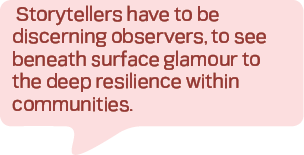 At Ivoh’s Annual summits, media makers are encouraged to inquire into the deeper meaning of the stories of our times. Judy believes that “If we are discerning – if we are awake to what is deepest and most persistent in the human spirit – we can feel the will of life and the foundation of virtue stirring beneath the surface. The insightful journalist, filmmaker, advertising professional or game developer will recognize this deeper truth and use his or her skill to uplift and elevate the societies they serve.” She encourages us all to look out for such stories, and when we see them, write to the media creators to let them know that we value stories like this. worldgoodwill.org/video#jr
At Ivoh’s Annual summits, media makers are encouraged to inquire into the deeper meaning of the stories of our times. Judy believes that “If we are discerning – if we are awake to what is deepest and most persistent in the human spirit – we can feel the will of life and the foundation of virtue stirring beneath the surface. The insightful journalist, filmmaker, advertising professional or game developer will recognize this deeper truth and use his or her skill to uplift and elevate the societies they serve.” She encourages us all to look out for such stories, and when we see them, write to the media creators to let them know that we value stories like this. worldgoodwill.org/video#jr
* https://www.youtube.com/watch?v=viUJVC5ykR4 on changing stereotypes about the state of Alabama, using Walt Whitman’s Song of Myself
Constructing a Universal Dialogue through Media Literacy
 Gabriel Jaraba is a professor at the Autonomous University of Barcelona, and the UNESCO Global Chair on Media Literacy and Intercultural Dialogue. Gabriel began by noting the key importance of media literacy as identified by UNESCO. He suggested that without media literacy, there can be no true democracy. The 21st century is an age of total communication, conditioning every aspect of life. Thus, we are in the midst of a period of media disruption, which he described as a “change of civilisation in all its aspects”. The question then arises – how can we act responsibly in this age?
Gabriel Jaraba is a professor at the Autonomous University of Barcelona, and the UNESCO Global Chair on Media Literacy and Intercultural Dialogue. Gabriel began by noting the key importance of media literacy as identified by UNESCO. He suggested that without media literacy, there can be no true democracy. The 21st century is an age of total communication, conditioning every aspect of life. Thus, we are in the midst of a period of media disruption, which he described as a “change of civilisation in all its aspects”. The question then arises – how can we act responsibly in this age?
We have a technological civilisation, based on the digitalisation of communication, combined with a media culture organised around the media and their convergence. This has three key impacts: on the energy needed to communicate; on time; and on space. The result is that we see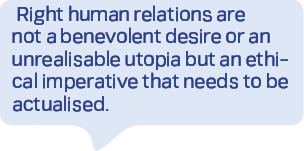 lightweight, instantaneous, global communications. How does this impact our collective responsibility to establish right human relations? We might be tempted to react with fear and seek to stifle this powerful trend, but in fact it is a great opportunity to advance planetary consciousness, with scope to greatly diffuse the Ageless Wisdom through the universal network of the Web, which is the physical manifestation of a true ‘noosphere’ or sphere of human thought, as predicted by Teilhard de Chardin.
lightweight, instantaneous, global communications. How does this impact our collective responsibility to establish right human relations? We might be tempted to react with fear and seek to stifle this powerful trend, but in fact it is a great opportunity to advance planetary consciousness, with scope to greatly diffuse the Ageless Wisdom through the universal network of the Web, which is the physical manifestation of a true ‘noosphere’ or sphere of human thought, as predicted by Teilhard de Chardin.
The existence of this physical manifestation of the mental plane implies our responsibility to preserve and nurture its correct growth so that it may become a useful vehicle of right human relations. To do so, Gabriel suggested, we should carefully guard it from the danger of being captured solely by big business. Major corporate platforms tend to stifle active communication of opinion in favour of passive information consumption. Thus, media education in schools is essential, but is not enough. It must respond to the dynamic technological landscape, to the new conditions created by social networks, and to the emergence of computer algorithms making decisions about what we see. Thus, the great challenge is for media education to bring to light the hidden power of the major platforms, and hold them to account for their impacts on the economy and society. However, it is not enough to be defensive, if democracy is to be preserved. Media literacy must become a practical example of applying right human relations – “Right human relations are not a  benevolent desire or an unrealisable utopia but an ethical imperative that needs to be actualised.” And media literacy can be expressed in both formal and informal contexts, in educational institutions and via social activism.
benevolent desire or an unrealisable utopia but an ethical imperative that needs to be actualised.” And media literacy can be expressed in both formal and informal contexts, in educational institutions and via social activism.
Gabriel shared his thoughts on the new values inspiring media literacy. First, there is the defence of autonomous individuals who have the right to information which they can critically assess. Second, a belief in the constructive value of open, participatory dialogue, in the ability of crowds and organised collectives to generate quality information, critical evaluation and decision-making processes, and the key importance of sharing knowledge. Third, the power of the creative imagination, which should fuel an active communicative democracy with equality of participation and expression of opinion. And fourthly a respect for cultural diversity and inter-cultural dialogue. “The new media literacy respects the autonomy of each culture and its singularity, because it builds bridges for the construction of a universal dialogue between them, for the construction of shared values.”
Media literacy should strengthen critical thinking and the ability to handle the information spread by the media. Key elements of these are:
“• knowing how to find and access the best information available using the most appropriate, diverse and
reliable sources
• knowing how to evaluate it with precise and rigorous criteria
• contextualising and understanding information according its source
• awareness of ideological and cultural context from and in information has been promoted
• integrating all the previous into a set of information and prior knowledge and obtaining a meaningful
result”
Developing these abilities enables the meaningful solution of problems in such areas as: intercultural conflicts; working to end prejudice and discrimination; creating networks of shared interest and values; democratic participation; limiting state power; corporate transparency; freedom of 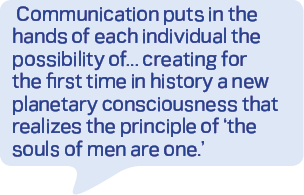 speech; and access to information.
speech; and access to information.
Finally, Gabriel noted, “It is no longer a matter of promoting national patriotism through literacy and education, but promoting, through media literacy, the feeling of universal citizenship oriented to a cosmopolitan belonging. Media are today active builders of the vision that each human group has of itself and of the others… Communication puts in the hands of each individual the possibility of… creating for the first time in history a new planetary consciousness that realizes the principle of ‘the souls of men are one.’” worldgoodwill.org/video#gj
Drawing Attention to the Good, Beautiful and True
 Alexandra Ratcliffe is an educator, thinker and freelance writer. Her work has appeared on The Huffington Post (huffpost.com) and she maintains her own website at www.soulfulconnections.uk She began by reflecting on the existence of many levels and meanings of truth, from the concrete to the subtle and the Absolute. However, there is currently a sense that all truth is relative to the individual: ‘Post-truth’ was the Oxford Dictionary’s word of the year for 2016, and the definition contains the implication that personal feeling is more important than rationality and facts. Another related term that has recently gained currency is ‘alternative facts’.
Alexandra Ratcliffe is an educator, thinker and freelance writer. Her work has appeared on The Huffington Post (huffpost.com) and she maintains her own website at www.soulfulconnections.uk She began by reflecting on the existence of many levels and meanings of truth, from the concrete to the subtle and the Absolute. However, there is currently a sense that all truth is relative to the individual: ‘Post-truth’ was the Oxford Dictionary’s word of the year for 2016, and the definition contains the implication that personal feeling is more important than rationality and facts. Another related term that has recently gained currency is ‘alternative facts’.
To establish the facts about an event historians distinguish between primary sources, which are first-hand accounts or evidence, and secondary sources, which are reports written about these. Tertiary sources combine elements from both primary and secondary sources. The further away in time or space we move from an event, the more likely it is to be distorted; and it is an unfortunate truth of journalism that direct reporting from primary sources is expensive. This financial pressure in the modern media landscape implies that second – and third-hand reporting tends to proliferate, pushing us further away from the truth. Compounding this is the fact that “Since humanity is hard-wired with Active Intelligence, we tend to be Information-Gatherers. And because information is available at the touch of a fingertip, and can be shared around the world in seconds, everyone can gather all the information they choose and determine their own truths to suit their personal version of reality.”
 Alexandra gave a brief history of information circulation, beginning with orators in ancient Greece, and moving on to pamphlet distribution in Rome, which was facilitated by the building of roads and waterways. Daily gazettes and bulletins, the precursors of newspapers, began to appear in Rome. In the 17th century, newspapers began to appear in Europe, and the idea of ‘propaganda’, defined as information used to influence or further an agenda, had started to take root. This intentional manipulation of public opinion has grown since then, and electronic sharing has accelerated the trend, along with new waves of deliberately false or misleading information. “Now, in the internet age, we have a virtual world of information and misinformation, side by side, ceaselessly whirling around the cybersphere.”
Alexandra gave a brief history of information circulation, beginning with orators in ancient Greece, and moving on to pamphlet distribution in Rome, which was facilitated by the building of roads and waterways. Daily gazettes and bulletins, the precursors of newspapers, began to appear in Rome. In the 17th century, newspapers began to appear in Europe, and the idea of ‘propaganda’, defined as information used to influence or further an agenda, had started to take root. This intentional manipulation of public opinion has grown since then, and electronic sharing has accelerated the trend, along with new waves of deliberately false or misleading information. “Now, in the internet age, we have a virtual world of information and misinformation, side by side, ceaselessly whirling around the cybersphere.”
The spread of misinformation has significant implications for democracy. As Yale history professor Tim Snyder has noted: “To abandon facts is to abandon freedom. And if nothing is true, then no one can criticize power because there is no basis upon which to do so.” This underlines the key need for educational systems which teach discernment and discrimination, and help integrate the physical, emotional and mental faculties, leading to contact with the intuition, “the ultimate discerner of truth.” Secondary education should include media literacy, civics, ethics and reflection on the impact of technology. A programme which she used called ‘Living Values for a Better World’ introduced the students to the concepts and vocabulary of peace, of empathy, of respect and tolerance. For child and adult alike, education on the reliability of information sources should be lifelong. This would help us to decide what and what not to share. There is a need for reflection on the intention of our words, and on how pure intentions and pure thinking clarify the mental atmosphere.
It is helpful to approach stories in the media by asking if they draw our attention to the good, the beautiful and the true. Each of us is responsible for contributing our share of these qualities to the mental and emotional life of humanity. An essential tool in this work is meditation, for it enables us to come into contact with the eternal truths which underlie all outer confusion, the truths that can set us free, truths such as the fact that love is the true fabric which binds humanity; and until we hear this being broadcast through the news, we are simply not hearing the whole story. Even a touch of these eternal truths can remove us one step from the confused and confusing sea of information and misinformation, setting us free. worldgoodwill.org/video#ar
University Courses on Meditation Can Awaken the Intuition
 Professor Dr. Andreas de Bruin of the University of Applied Sciences, Munich, founded the Munich Model “Meditation at University” in 2010. He is now teaching meditation classes in nine fields of study at four faculties. Andreas began by indicating that his intention in creating the meditation-based ‘Munich Model’ was to allow the introduction of intuition into universities. The global problems that we have created have been made by the application of the intellect, and we need the intuition to help us solve these.
Professor Dr. Andreas de Bruin of the University of Applied Sciences, Munich, founded the Munich Model “Meditation at University” in 2010. He is now teaching meditation classes in nine fields of study at four faculties. Andreas began by indicating that his intention in creating the meditation-based ‘Munich Model’ was to allow the introduction of intuition into universities. The global problems that we have created have been made by the application of the intellect, and we need the intuition to help us solve these.
 Andreas referred to the work of biologist, philosopher and neuro-scientist Francisco Varela and psychologist Daniel Goleman, who concluded that science’s major contribution to the 21st century would be to tackle destructive emotions, which are the underlying causes of most planetary problems. They initiated a dialogue with the Dalai Lama and other Buddhist monks on the value of meditation and mindfulness, and the results of their research are available at www.mindandlife.org. Andreas sees this work as the seed of the boom in research into the value of mindfulness. He feels that mindfulness is the precursor stage to true meditation, which only takes place when there is integration within the personality, allowing the link with the soul to begin to be built. At this point real control over the mind can begin to be established, and many of the students who have joined his courses say that they want to improve their control over their minds. While numerous programmes bring mindfulness into universities and businesses in order to build concentration skills and strategies to cope with stress, for him, the deeper twofold purpose is to allow students to connect with the soul, and then to bring out these soul energies in creative service to society.“…it was important to bring in meditation…, so that we can help the students to get more in touch with themselves and maybe also bring to the outside, what they have inside themselves and then for society.”
Andreas referred to the work of biologist, philosopher and neuro-scientist Francisco Varela and psychologist Daniel Goleman, who concluded that science’s major contribution to the 21st century would be to tackle destructive emotions, which are the underlying causes of most planetary problems. They initiated a dialogue with the Dalai Lama and other Buddhist monks on the value of meditation and mindfulness, and the results of their research are available at www.mindandlife.org. Andreas sees this work as the seed of the boom in research into the value of mindfulness. He feels that mindfulness is the precursor stage to true meditation, which only takes place when there is integration within the personality, allowing the link with the soul to begin to be built. At this point real control over the mind can begin to be established, and many of the students who have joined his courses say that they want to improve their control over their minds. While numerous programmes bring mindfulness into universities and businesses in order to build concentration skills and strategies to cope with stress, for him, the deeper twofold purpose is to allow students to connect with the soul, and then to bring out these soul energies in creative service to society.“…it was important to bring in meditation…, so that we can help the students to get more in touch with themselves and maybe also bring to the outside, what they have inside themselves and then for society.”
The Munich Model has developed from small beginnings in 2010, when 15 places were offered – now in 2017, there are 9 fields of study at 4 faculties, with 150 students per semester. The model is also being adopted at other universities. Courses emphasise active participation. Each student keeps a diary on how they build meditation into their daily life. This allows them to explore how meditation can be meaningfully incorporated into their own field of study, for example, teacher education. The practical exercises include  mindful communication, mindful eating and cooking, mindfulness and breathing, sound in meditation etc.. There is also reference to the research currently going on into meditation in various areas, such as how meditation can be applied in prisons, hospitals and other places. Students practice various different meditation techniques, and those who are interested in taking a particular technique further can follow up with outside experts. There are also more philosophical discussions, and film showings on topics relating to meditation.
mindful communication, mindful eating and cooking, mindfulness and breathing, sound in meditation etc.. There is also reference to the research currently going on into meditation in various areas, such as how meditation can be applied in prisons, hospitals and other places. Students practice various different meditation techniques, and those who are interested in taking a particular technique further can follow up with outside experts. There are also more philosophical discussions, and film showings on topics relating to meditation.
Andreas concluded by discussing his latest project which focuses on the application of meditation to appreciating the art of the Old Masters. Some research indicates that meditation allows a deepened perception of art. Andreas has conducted small group experiments in this at the Rijksmuseum in Amsterdam, with mindful walking to the painting, followed by mindful observation, with sub-groups considering different aspects of the image. For him, applying meditation in the context of art appreciation, and in universities, is part of its more general application to our lives, allowing us to shape them wisely in service to the whole. worldgoodwill.org/video#ab
In our next issue, we will be exploring From the Unreal to the Real as it relates to science, philosophy and the arts.


